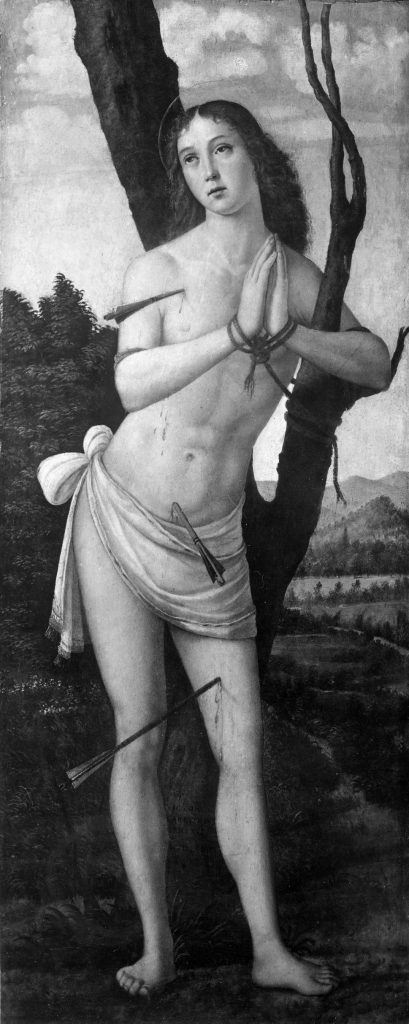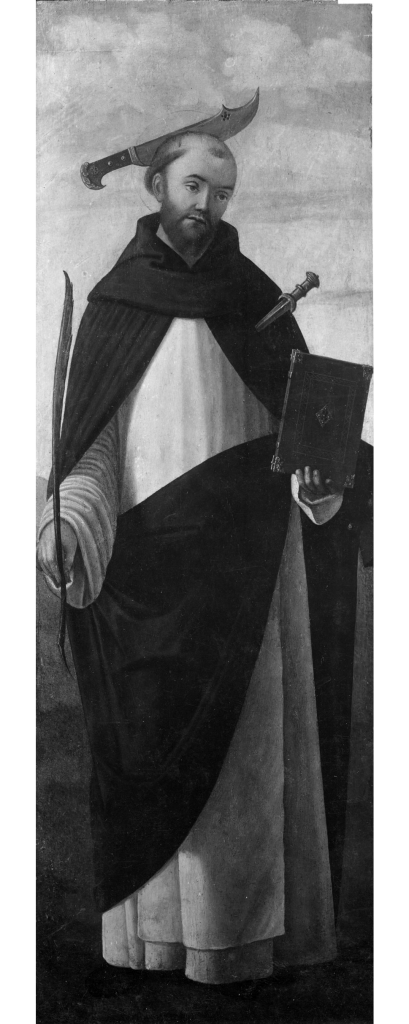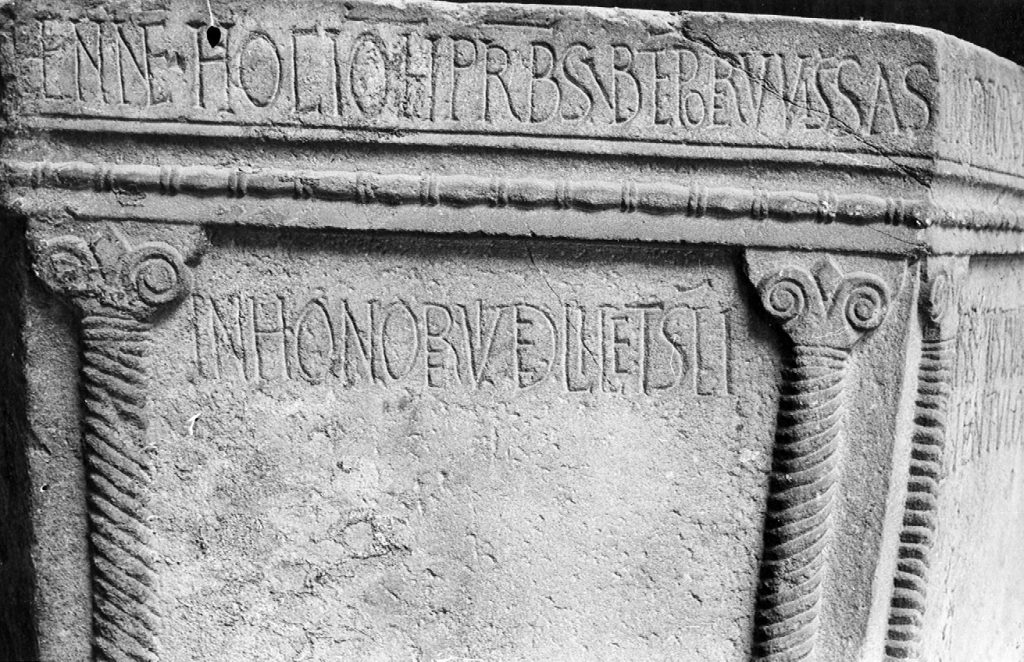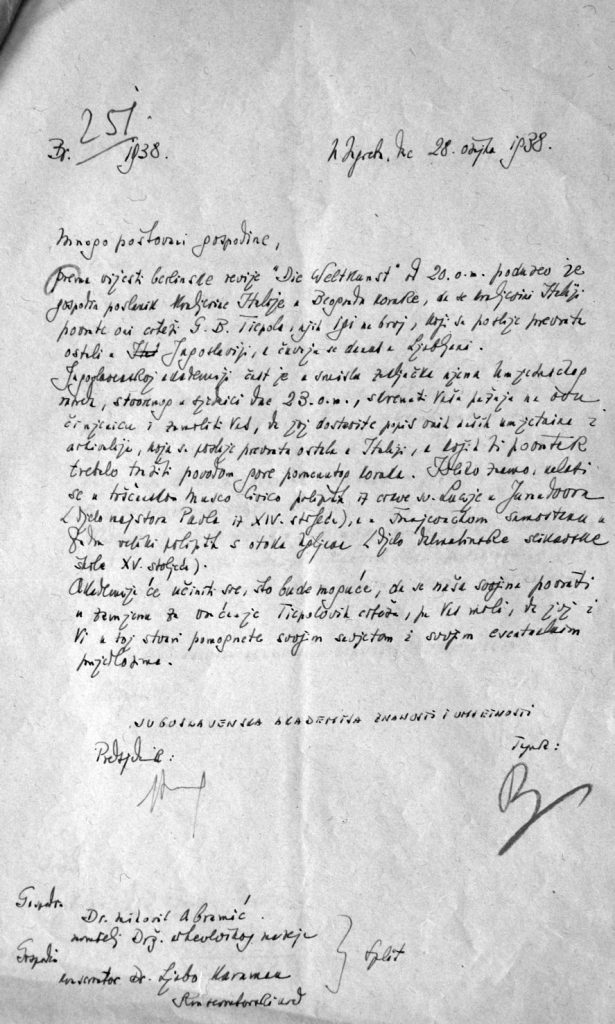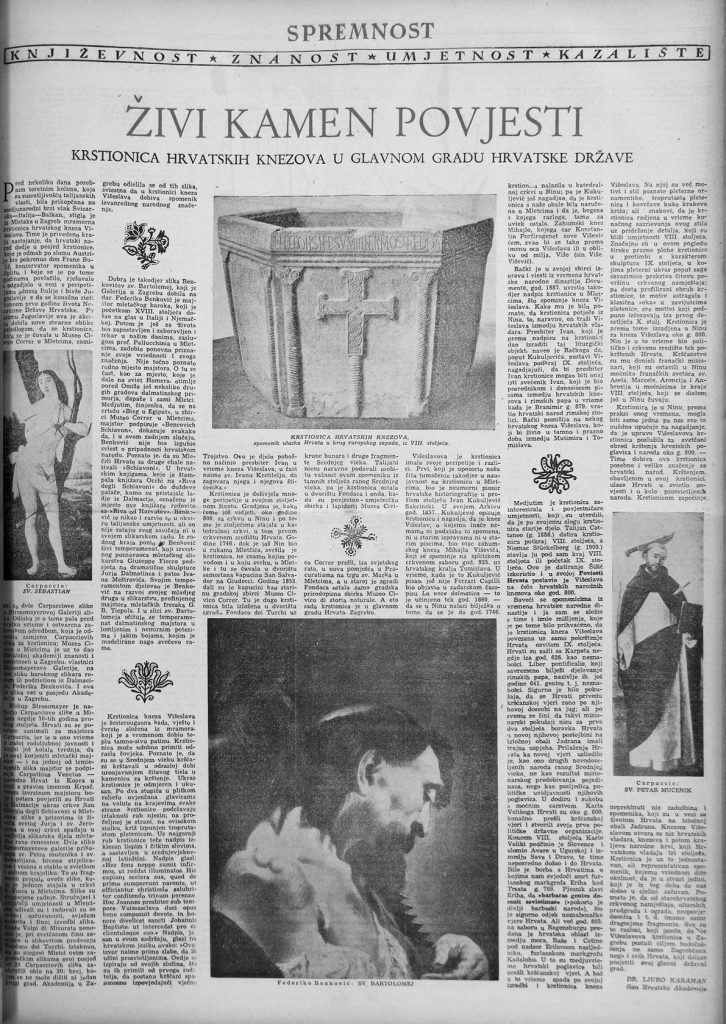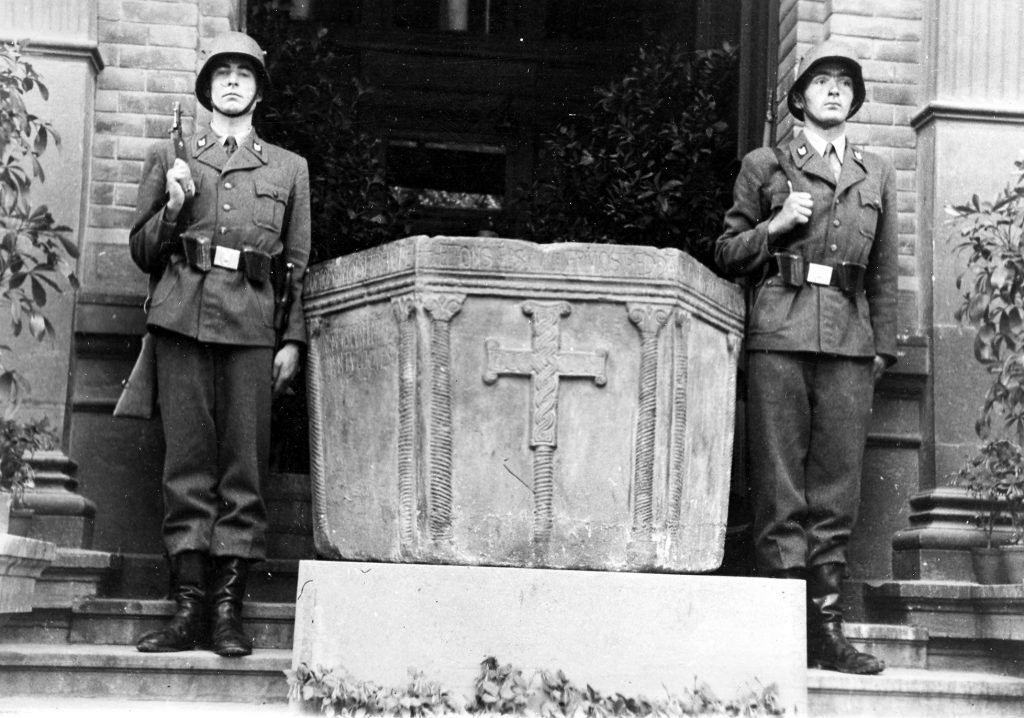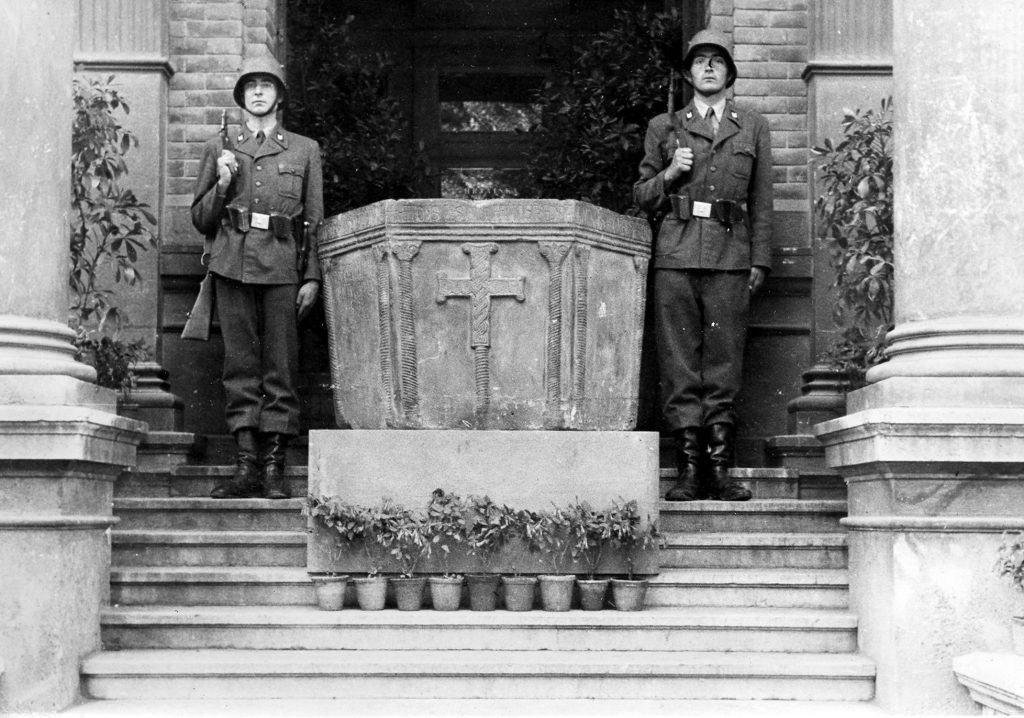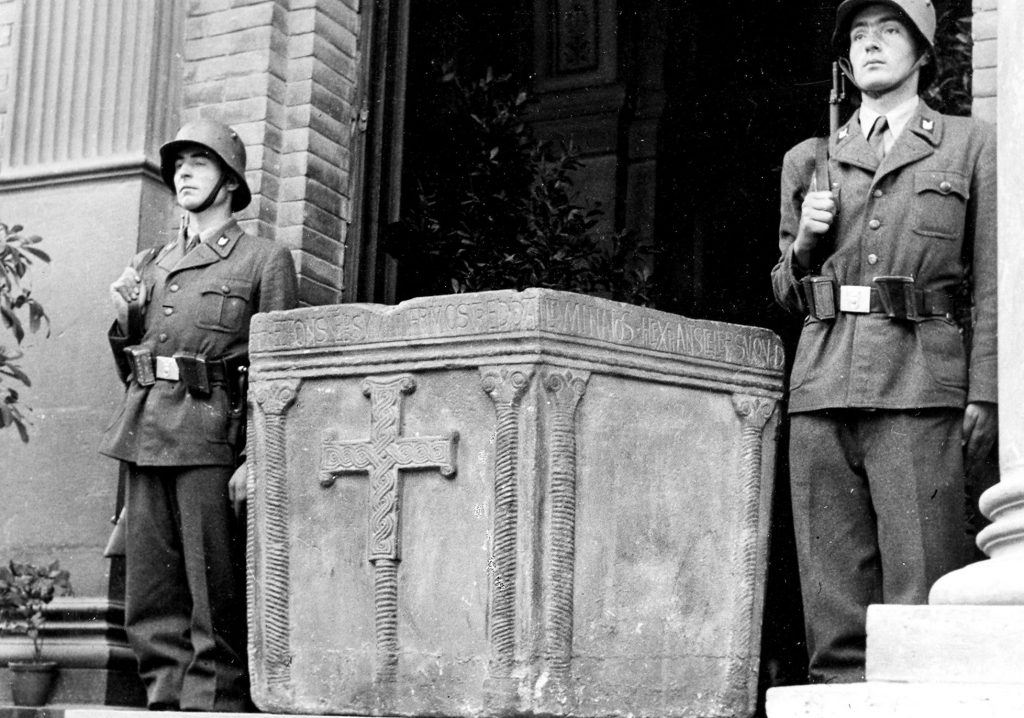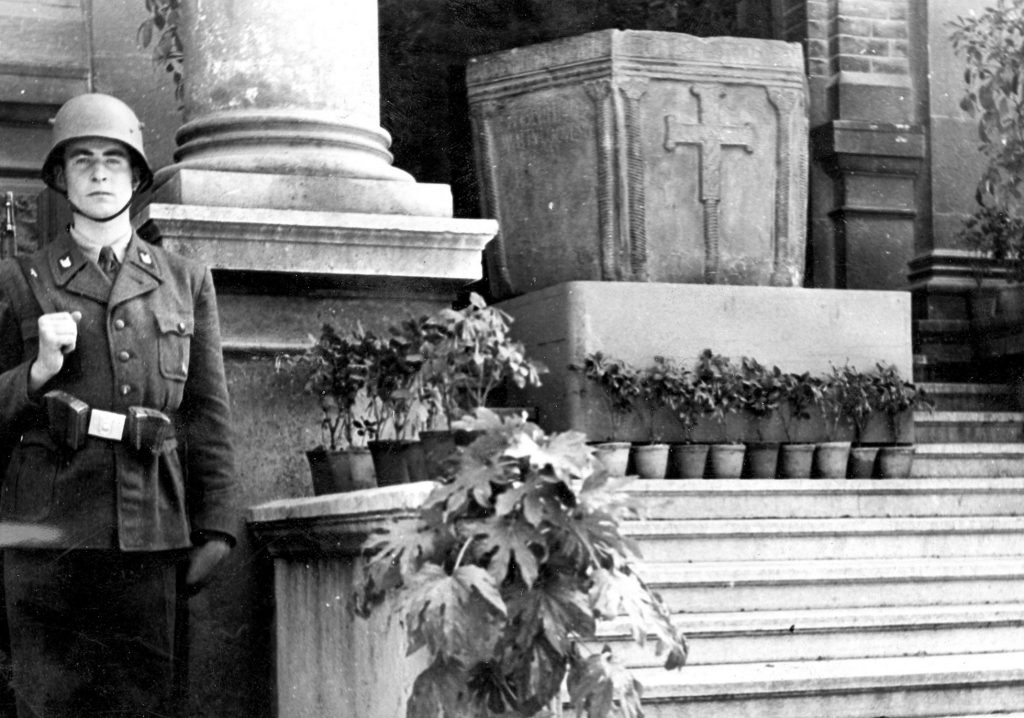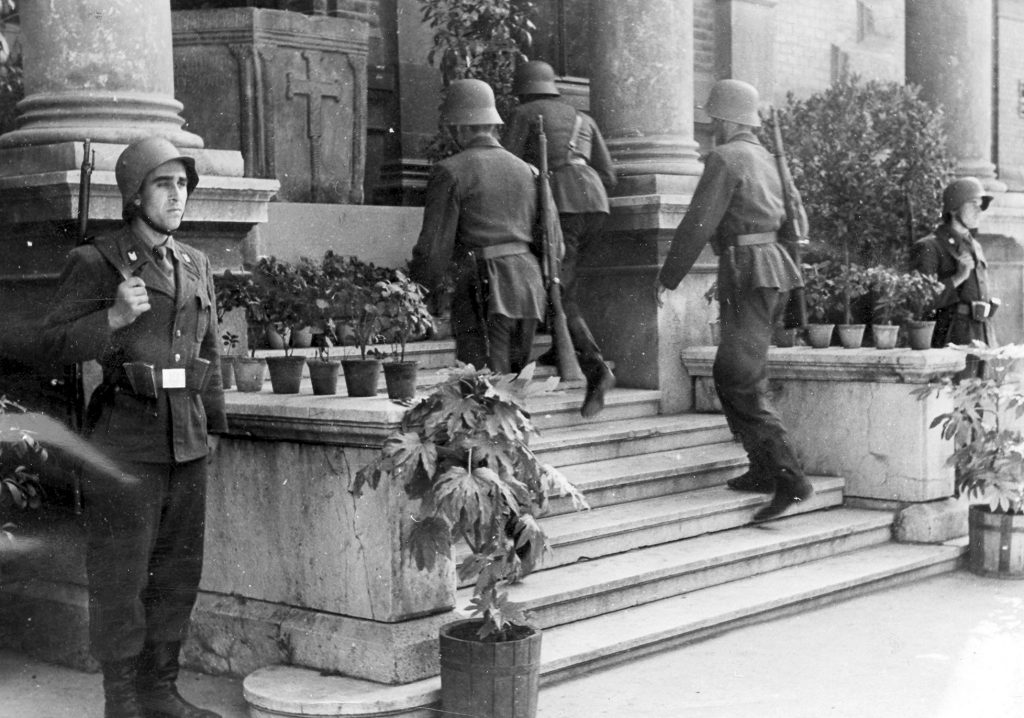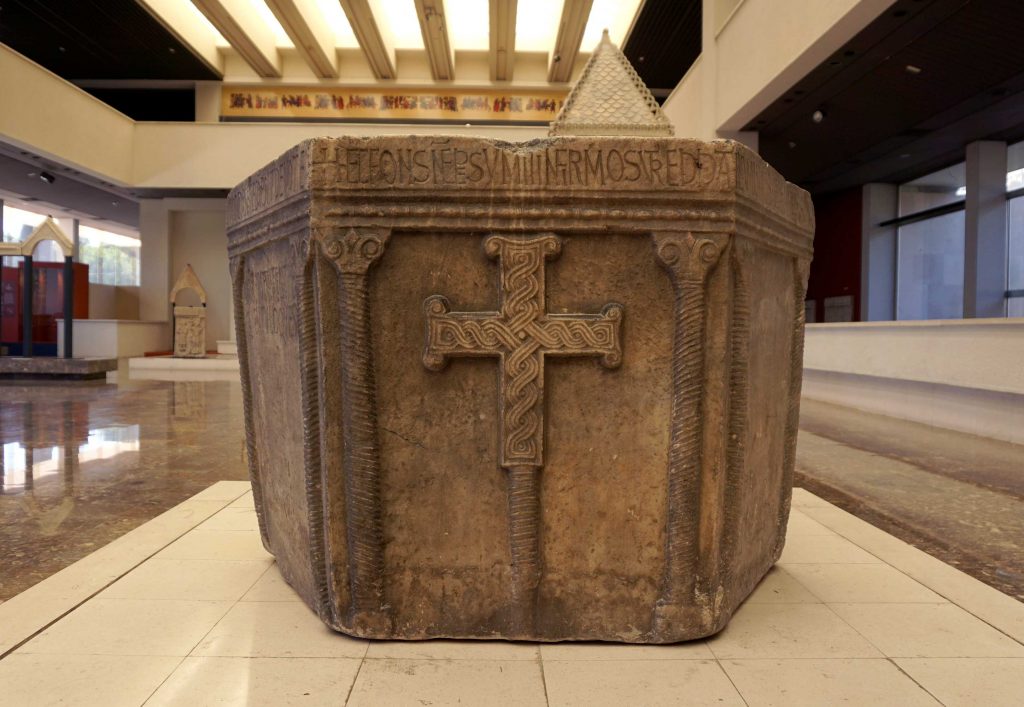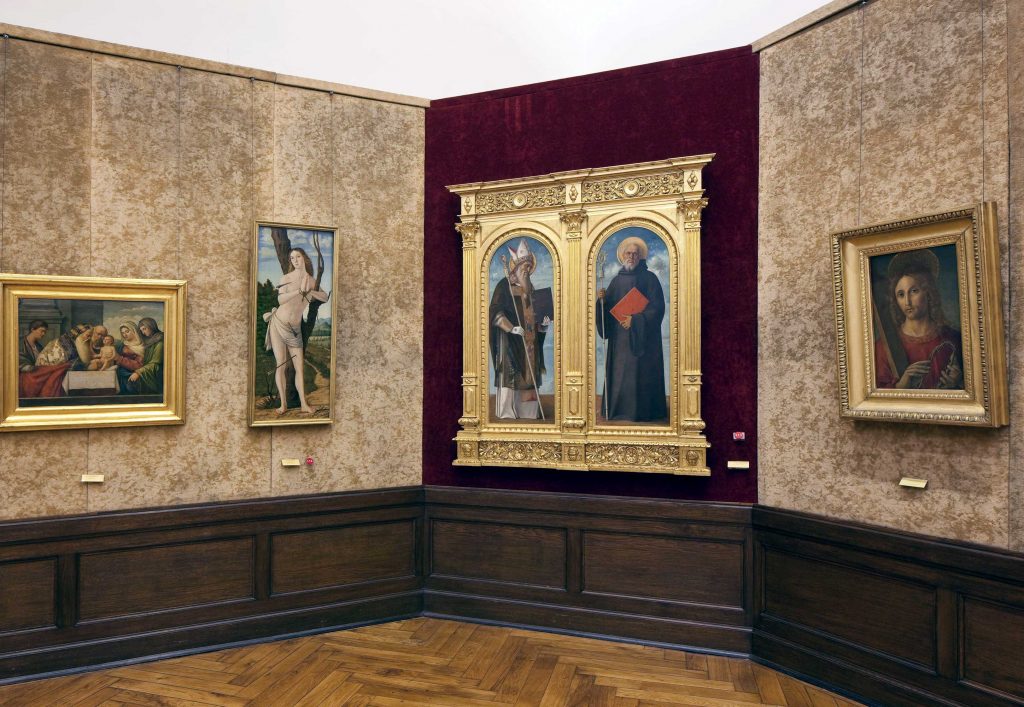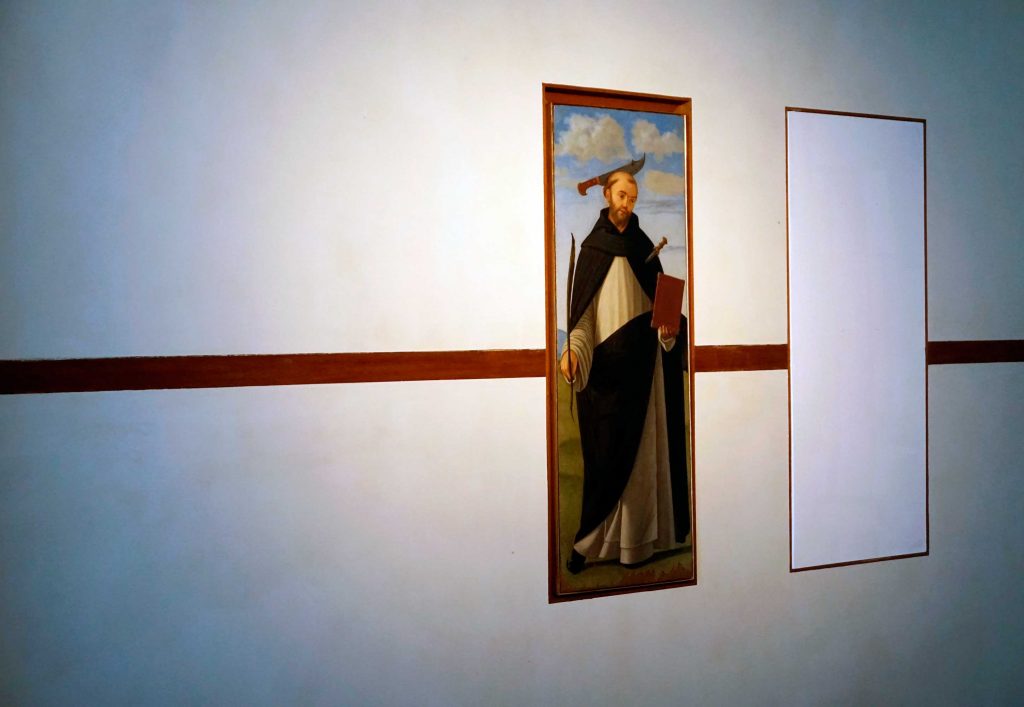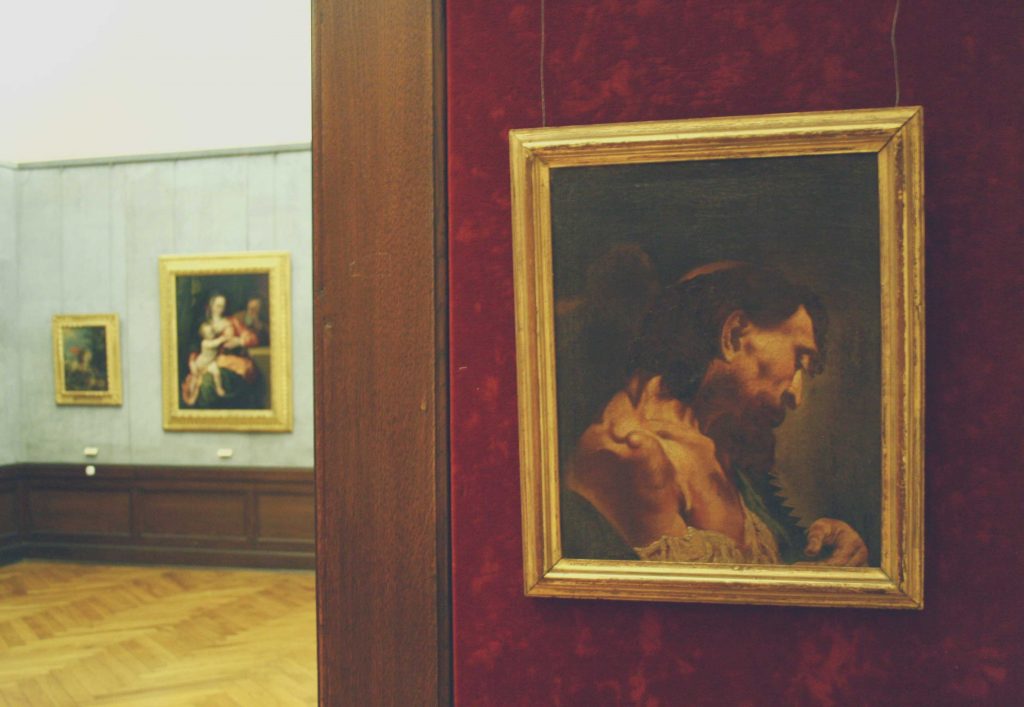
THE STROSSMAYER GALLERY – MUSEO CORRER
1942 EXCHANGE
ONLINE EXHIBITION
Introduction
Saint Sebastian
Saint Peter the Martyr
The so-called Baptismal Font of Duke Višeslav
Post-WWI Restitution Negotiations
Documentation on the restitution process has been preserved in the Strossmayer Gallery Archive in Zagreb. Dating from 1938, these documents were created or compiled, when the Italian government renewed their claim for the return of Tiepolo’s drawings from the Sartorio Collection in Trieste, which had been left in Ljubljana during the First World War.
In 1838, the German magazine Die Weltkunst published a short story about the Italian claim, and Artur Schneider, director of the Strossmayer Gallery at the time, felt invited to respond. Schneider’s official letter issued to several addresses held a warning that the drawings must not be returned until the restitution of “all those artworks of ours which were detained in Italy after the upheaval”.
All of the artworks and collections whose status was considered in the restitution negotiations during the mid-war period were summarized in a report by Mihovil Abramić, director of the Archeological Museum in Split, who was an official representative in the restitution negotiations.
Artur Schneider's letter
1938 Report
Abramić’s report contains information on the proceedings of the action and a detailed list of artworks whose restitution was sought.
The objects of the negotiations were divided into three groups: historical documents that were left in Zadar as the “former capital of Dalmatia”, objects that the Italian army seized during the occupation of the so-called “third zone” in northern Dalmatia, and finally, artworks which came into temporary Italian possession “by chance”, due to the post-WWI redefinitions of state borders. Even though an uncontested return was sought for the final group of objects, some items were singled out that were not sought back, but for which an exchange was proposed for the so-called Baptismal Font of Duke Višeslav, as an “object of compensation”.
At a meeting held in July 1926 in Trieste, Abramić discussed all the claims with the Italian referent of the Yugoslav-Italian commission, Ettore Modigliani. Abramić explained the reasons behind this suggested compensation: “this object is a monument of great value to our national history, while to the Italians it represents nothing.” Modigliani then promised that he would “intercede for our justified requests and wishes”, informing Abramić in the fall of 1927 that “the president of the Italian government, Mr. Mussolini himself, got involved in the question of the restitution of your artworks, and promised to serve as intermediary with the Venetian local government, so that the Baptismal Font be returned”.
1941 Initiative
Although the initiative to transfer the Baptismal Font to Croatia in the framework of the post-WWI restitution negotiations was never abandoned, the transfer was finally realized only in the course of the Second World War.
In 1941, Zagreb’s Archbishop Alojzije Stepinac personally interceded for the transfer of the Baptismal Font to Croatia with the Venetian Cardinal Piazza, who suggested that this should be done through the Ministry in Belgrade. This action was soon interrupted by the German occupation of Yugoslavia and the establishment of the Independent State of Croatia. Therefore, in May of 1941, Stepinac addressed Milo Budak, Minister of Education in the newly established State in Zagreb: “He conveyed to him what he had, until that point, achieved in this matter, as well as the fact that he had received a visit from Venetian professor Ponti, who is currently staying and working in Zagreb, letting him know that this will be easiest to achieve if the Font was exchanged for a painting by one of the Venetian painters. On 13th of September, the Archbishop received a notification from the ‘Istituto di cultura italiana’ in Zagreb, imparted to him by professor Ponti himself, that the Mayor of Venice, along with the Board of the city museums of Venice, accepted his suggestion to perform the proposed exchange. Two paintings by Carpaccio, owned by the Strossmayer Gallery in Zagreb, will be given to Venice in exchange for the Baptismal Font of Duke Višeslav.” (Aleksa Benigar, Alojzije Stepinac: hrvatski kardinal, Rome, 1974, p. 251)
Giovanni Ponti
(Venice, 1896 – Padua, 1961)
The subsequently respectable Mayor of Venice resided in Zagreb 1940-42 as a professor and lecturer of Italian at the Faculty of Philosophy.
1942 Decree on the Exchange
In February of 1942, the Croatian Academy of Sciences and Arts, under whose authority the Strossmayer Gallery operates, received the decision of the Head of the Independent State of Croatia, Ante Pavelić, which he had sent to the Ministry of Education, in which he asserts that “the exchange is to take place according to the modalities that will be subsequently determined.” (Minutes of the Gallery Committee session, February 21, 1942. SGA, Box 4, 1939-1943, 1942)
Pavelić’s decision gained legal power as an official Decree on the Exchange of Two Paintings by Vittore Carpaccio from the Croatian Gallery of Sciences and Arts in Zagreb for the Baptismal Font of the Croatian Duke Višeslav from the Museo Civico Correr in Venice, issued on 22nd May 1942.
Saint Peter the Martyr and Saint Sebastian were transferred from Zagreb to Venice, the Baptismal Font was transferred from Venice to Zagreb, together with the painting Saint Simeon, gifted by the Museo Correr to the Strossmayer Gallery in the occasion of exchange.
Font's Transfer to Croatia
On the occasion of the transfer of the Font to Croatia, Ljubo Karaman, former Head of the Conservation Office in Split, and in 1942 Head Conservator for Croatia, accepted “the assumption that it [the Font] was used in the solemn rite of baptizing Croatia’s people and leaders around the year 800.” He continued by saying: “This imbues the Font with great significance for the Croatian people. The baptizing performed in this Font took the Croatian people into the light of history, and into the realm of enlightened nations. This Font began the uninterrupted sequence of endowments and monuments connected to the lives of the Croatian people on the eastern shores of the Adriatic. […] On the occasion of the first anniversary of the establishment of the Independent State of Croatia, Duke Višeslav’s Baptismal Font returns as an ancient rarity to the Croatian people, and into the Croatian Academy in Zagreb.”
Živi kamen povjesti. Krstionica hrvatskih knezova u glavnom gradu Hrvatske države
Font's Display in Zagreb
The Font was exhibited at the Academy’s doors, while students of Zagreb’s schools walked in a parade in front of it: “The Ministry of Education is planning to hold a parade in front of the Baptismal Font of Duke Višeslav on Sunday, 30th August, at 10 a. m., participants of which will be students from primary and secondary schools of Zagreb. Students will march in front of the building of the Croatian Academy of Sciences and Arts and, looking towards the Font in proper stance and form, show due tribute and respect with their right arms held in salute.” (Ministry of Education to the Croatian Academy, August 27, 1942. HAZU Archive, Box 82, 1942)
The transfer of the Font to Zagreb was hereby presented as a pompous public display, whose aim was to legitimize the new political regime and its alliance with fascist Italy.
Post-WWII Restitution
The exchanged objects were further dealt with in the post-WWII years. Negotiations terminated in 1961, by signing the “final agreement between the Federal National Republic of Yugoslavia and The Republic of Italy” on 15th September 1961.
The Baptismal Font has stayed in the Museum Of Croatian Archaeological Monuments in Split (where it was transferred from the Croatian Academy in 1958), Saint Peter the Martyr has stayed in the Museo Correr in Venice, while Saint Sebastian has been returned to the Strossmayer Gallery, where the painting Saint Simeon gifted by the Museo Correr during the exchange of 1942, has also remained.
Archival Sources and Literature
Archival Sources:
- Archives of the Croatian Academy of Sciences and Arts (HAZU Archives)
- Archivio Generale Venezia, Sostanza Museo Correr
- Correr Museum Archives, Cl. XXV. n. 35, Ms Cicogna 3007/1
- Croatian State Archives, Ministarstvo prosvjete Narodne Republike Hrvatske (HDA 291), Služba državne sigurnosti Republičkog sekretarijata za unutrašnje poslove Socijalističke Republike Hrvatske (HDA 1561)
- Faculty of Humanities and Social Sciences, Zagreb University Archives
- Ministry of Culture of the Republic of Croatia, Uprava za zaštitu kulturne baštine, Središnji arhiv, Zbirke starije građe (Dokumentacijska građa Konzervatorskog ureda)
- Strossmayer Gallery of Old Masters’ Archives (SGA)
Literature:
- “191 Zeichnungen von Tiepolo,” Die Weltkunst, March 20, 1938, p. 4.
- Aleksa Benigar, Alojzije Stepinac: hrvatski kardinal, Rome, 1974.
- Grazia Bravar, “Storia di una Collezione,” in Aldo Rizzi (ed.), Giambattista Tiepolo. Disegni dai Civici Musei di Storia e Arte di Trieste [exhibition catalogue, Trieste, Civico Museo Sartorio, 18 December 1988 – 2 April 1989], Milano, 1988, pp. 11-13.
- Ljerka Dulibić and Iva Pasini Tržec, “The Pre- and After- Lives of Transferred Museum Objects: On the Exchange of Two Paintings from the Strossmayer Gallery in Zagreb for a Baptismal Font from the Venetian Museo Correr, 1942,” in Art and Politics Conference Proceedings, Zagreb (July 2016), yet to be published.
- Ljerka Dulibić and Iva Pasini Tržec, “Zamjena dviju slika Vittorea Carpaccia iz Strossmayerove galerije za Višeslavovu odnosno Krstionicu svećenika Ivana iz Muzeja Correr,” submitted for publication in Ars Adriatica.
- Ljerka Dulibić, Iva Pasini Tržec and Borivoj Popovčak, Strossmayerova galerija starih majstora – Odabrana djela. The Strossmayer Gallery of Old Masters. Selected Works, Zagreb, 2013.
- Nikola Jakšić, Klesarstvo u službi evangelizacije. Studije iz predromaničke skulpture na Jadranu, Split, 2015, pp. 377-386, 387-416.
- Nikola Jakšić, „Una vasca battesimale altomedievale fra le due sponde dell’Adriatico“ in Alexandra Chavarría Arnau and Miljenko Jurković, Alla ricerca di un passato complesso. Contributi in onore di Gian Pietro Brogiolo per il suo settantesimo compleanno, Zagreb, Motovun, 2016, pp. 243-256.
- Ljubo Karaman, “Živi kamen povjesti. Krstionica hrvatskih knezova u glavnom gradu Hrvatske države,” Spremnost, June 14, 1942, p. 9.
- Ivy Kugli, “Benkovićev Sv. Bartolomej u Galeriji Jugoslavenske akademije,” Čovjek i prostor, 4/6 (1957), p. 64.
- Vincenzo Lazari, Notizia delle opere d’arte et d’antichità della Raccolta Correr di Venezia, Venice, 1859, pp. 263-265.
- Mirjana Matijević Sokol, “Krsni zdenac Hrvata. Paleografsko-epigrafska raščlamba natpisa s krstionice kneza Višeslava,” Croatica Christiana periodica, 31/59 (2007), pp. 1-31.
- Iva Pasini Tržec and Ljerka Dulibić, “Die Strossmayer-Galerie Alter Meister in Zagreb in der Zeit des Unabhängigen Staates Kroatien 1941-1945,” in Tanja Baensch, Kristina Kratz-Kessemeier and Dorothee Wimmer (ed.), Museen im Nationalsozialismus. Akteure – Orte – Politik, Köln, Weimar, Wien, 2016, pp. 263-274.
- Iva Pasini Tržec and Ljerka Dulibić, “Slike starih majstora u Strossmayerovoj zbirci nabavljene posredstvom kanonika Nikole Voršaka u razdoblju od 1869. do 1880.,” Radovi IPU, 35 (2011), pp. 207-220.
- Ivo Petriciolli, “Krstionica s imenom ’Vuissasclavo duci’ i problem ninskog baptisterija,” Starohrvatska prosvjeta, 3/14 (1984), pp. 125-134.
- “Ponti Giovanni,” in Omar Favaro and Giuseppe Saccà, Dizionario Biografico dei Politici Veneziani. Profili di Amministratori, 1946-1993, Mestre, 2011, pp. 111-113.
- “Restitucija kulturnih dobara iz Italije. Govor koji je drugarica Anica Magašić, predsjednik Savjeta za nauku i kulturu NRH, održala u Jugoslavenskoj akademiji u Zagrebu, povodom vraćanja Carpacciove slike ‘Sv. Sebastijan’ galeriji te ustanove,” Telegram, December 22, 1961, p. 3.
- Giandomenico Romanelli (ed.), Carpaccio Vittore e Benedetto da Venezia all’Istria [exhibition catalogue, Conegliano, Galleria Comunale d’Arte Moderna, 7 March – 28 June 2015], Venice, 2015.
- Giorgio Vigni, Disegni del Tiepolo, Padua, 1942, pp. 13-14.

